
Email surveys have emerged as a critical tool for businesses seeking to improve their products and services. Simply sending out some questions through generic email survey templates will not do the trick.
Imagine you’re eager to enhance your business strategy and take proactive steps toward improvement. Your first move is to gather customer feedback through email surveys, but you’re unfortunately faced with a lack of responses. What could be causing this?
This is a common challenge since most customers respond to only about 14% of surveys (unless the company is well-known and famous). In this case, they may increase their response rate to 25%.
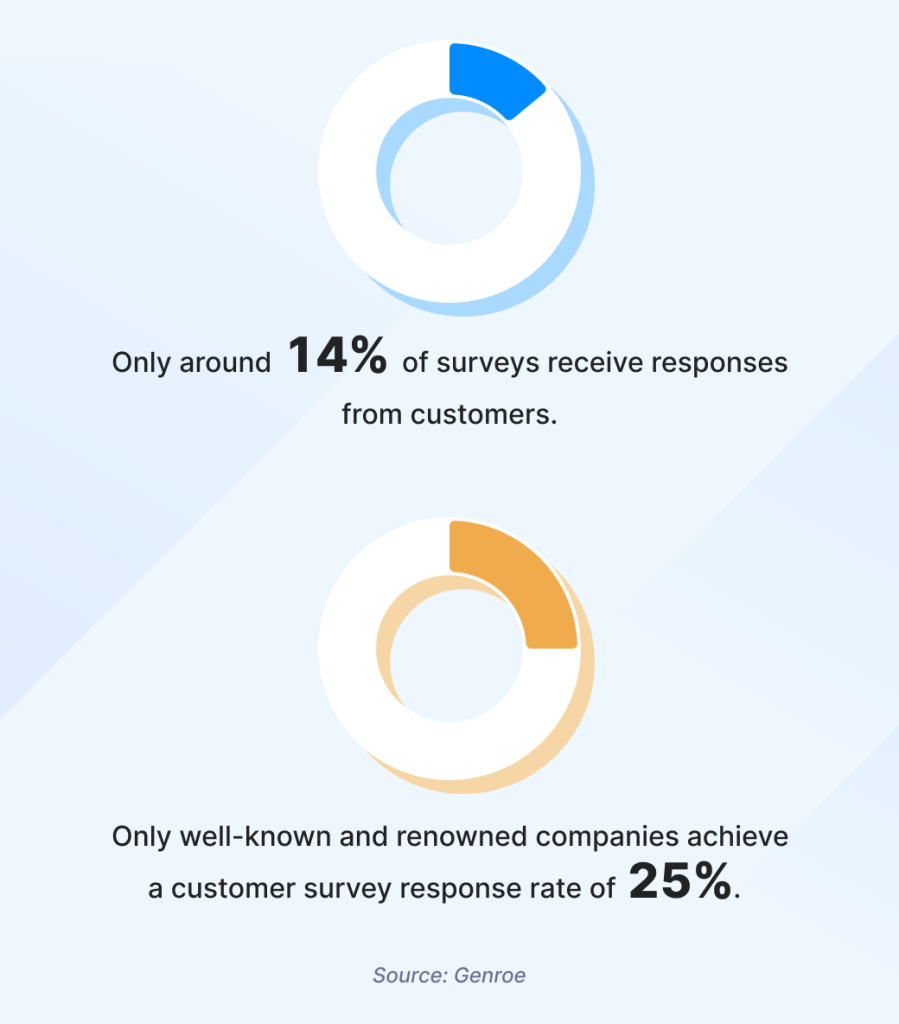
Therefore, crafting well-designed and engaging email surveys is key to obtaining meaningful responses that drive actionable insights. This blog post delves into email surveys and shares 15 meticulously crafted email survey templates. They are designed to guarantee valuable customer feedback from a wide range of industries.
The importance of email surveys
With just a few clicks and using different formats, you can reach a wide audience, collect feedback from multiple customers simultaneously, as well as automate the data collection process. Customers can complete these surveys at their convenience, choosing a time that suits them best. This enables them to respond more thoughtfully and in detail.
The flexibility of email surveys allows you to create targeted surveys for different customer segments and to track customer satisfaction over time. This ensures that you collect the most relevant and actionable feedback from your desired customer group.
📧 Email survey templates also play a crucial role in customer support. Some companies use customer service email templates to send customers emails asking for feedback immediately after interacting with the support team.
The benefits of email surveys
Email surveys offer several main benefits:
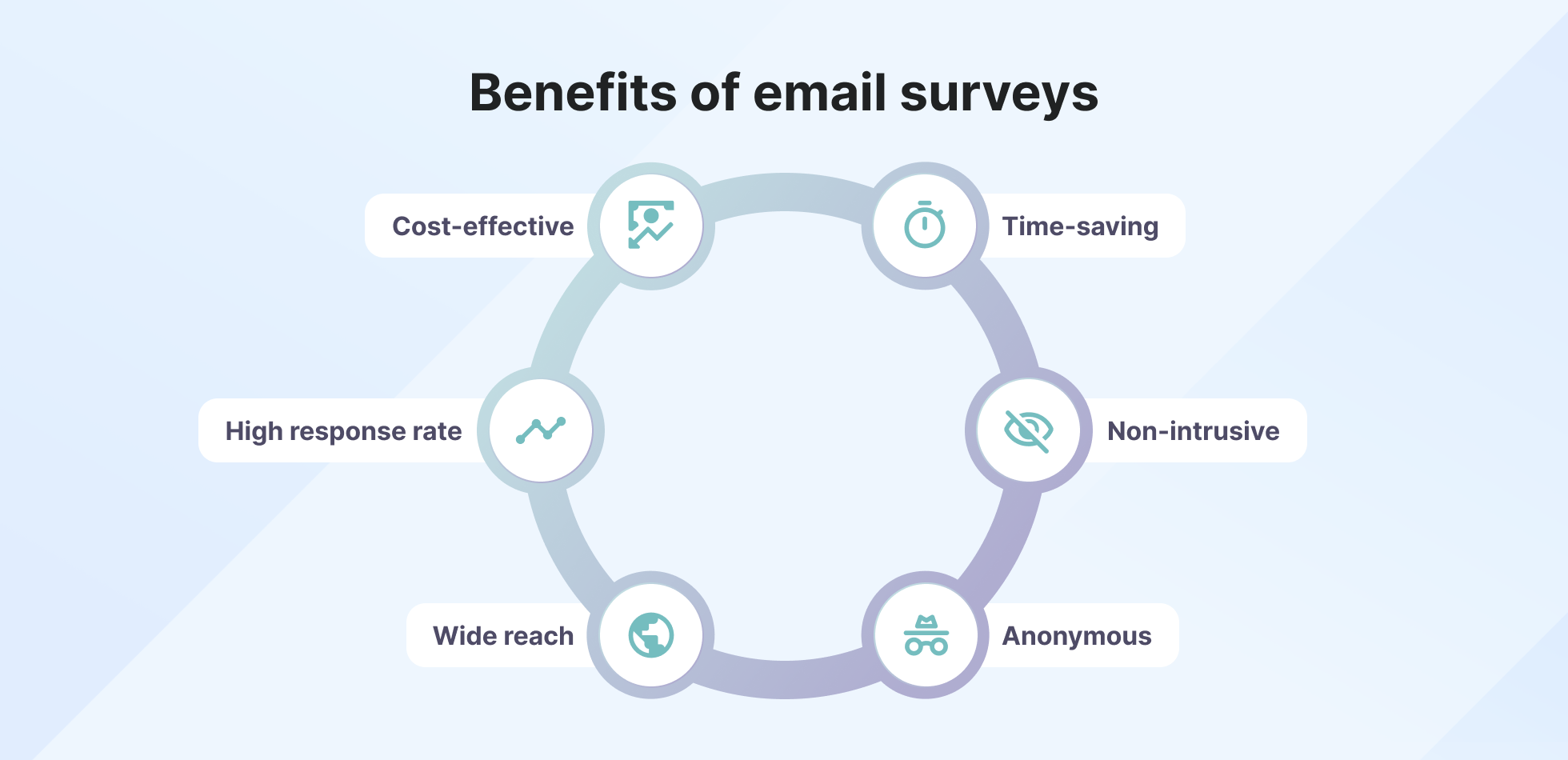
- Cost-effective: Email marketing tools allow you to easily design, distribute, and collect responses without manual data entry and at a very low cost per response.
- Time-saving: Email surveys can be sent to many customers simultaneously with just a few clicks. This automation saves valuable time and resources.
- Non-intrusive: An email list with a double opt-in allows customers to respond to your email surveys willingly.
- Anonymous: This approach ensures the reception of honest survey responses. If you were a respondent, would you feel comfortable answering sensitive questions if your identity was going to be revealed? Probably not.
- Wide reach: Email surveys are sent directly to the inbox, regardless of the customer’s physical location. This makes feedback collection from a broader customer base easier.
- High response rate: Email surveys often yield higher response rates than other survey methods. Customers engage with surveys when they can access and complete them conveniently using their preferred devices.
The ideal structure of a survey email
A survey email contains several key elements that contribute to its effectiveness.
- Subject line: Craft a compelling and attention-grabbing subject line that entices recipients to open the email.
- Body: Provide participation instructions, highlighting the benefits customers will receive from providing answers.
- Accompanying images: Don’t forget to include images and other elements that capture people’s attention and are likely to convince them to click on your survey link.
- Link to the survey: If the survey can’t be completed directly on the email page, include a prominently displayed and easily accessible link to ensure that recipients can quickly access and participate interactively.
- Call to action (CTA): Include a strong, persuasive CTA that encourages recipients to click the survey link and provide feedback.
Email survey templates for guaranteed feedback
Creating a powerful survey email becomes effortless once you grasp the essential elements to emphasize. To assist you further, here are 15 email survey templates. You may customize these templates for various purposes, whether for an email marketing questionnaire or general customer surveys.
1. Onboarding feedback email
Businesses usually send new customers an onboarding feedback email shortly after they begin using a product or service. This email aims to gather feedback about the onboarding process and the customers’ initial experience with the product or service.
Subject line: Share your onboarding experience and help us improve
Dear [Customer name],
We value your input and want to ensure that your onboarding journey with our [product/service] is exceptional.
That is why we kindly request a few moments of your time to provide valuable feedback on your recent onboarding process.
This email survey aims to gather insights into your experience, training materials, support received, and any areas where we can enhance the onboarding process: [link to your survey]
We appreciate your participation and look forward to your valuable input.
Best regards,
[Your name]
[Your position]
[Your company name]
2. Survey invitation email
When an organization sends an email inviting people to participate in a survey, it usually starts with a friendly greeting and explains the purpose of the survey. The email may also emphasize the advantages of taking part in the survey, including the opportunity to win rewards or enjoy special discounts.
Subject line: Limited time offer — exclusive discount and survey invitation
Dear [Customer name],
I hope this email finds you well. Your opinion matters to us, and we strive to continuously improve our products and services based on your valuable insights.
To start, simply click the link to access the survey: [link to your survey]
Rest assured — all your responses will be treated with the utmost confidentiality. The survey has been thoughtfully designed to be user-friendly and should not take more than [estimated time] to complete.
After you complete the survey, you will receive a unique discount code that can be redeemed on our website. [Provide a brief explanation of the discount].
Thank you for being an essential part of our community!
Warm regards,
[Your name]
[Your position]
[Your company name]
3. NPS survey email
The net promoter score (NPS) survey email aims to capture customer sentiment while measuring their satisfaction level. This helps your company identify areas for improvement and gauge its overall customer experience.
Subject line: [Customer name], we value your feedback — please complete our survey
Dear [Customer name],
Your satisfaction is very important to us, which is why we would greatly appreciate your feedback.
We would like you to answer one simple question: How likely are you to recommend [Your company name] to a friend or colleague?
[include NPS grading directly in the email]
The survey will take only a few minutes, and your feedback will be anonymous.
Once again, we appreciate your participation and thank you for being a valued subscriber. We look forward to continually improving your experience with our products and services based on your valuable insights.
Warm regards,
[Your name]
[Your position]
[Your company name]
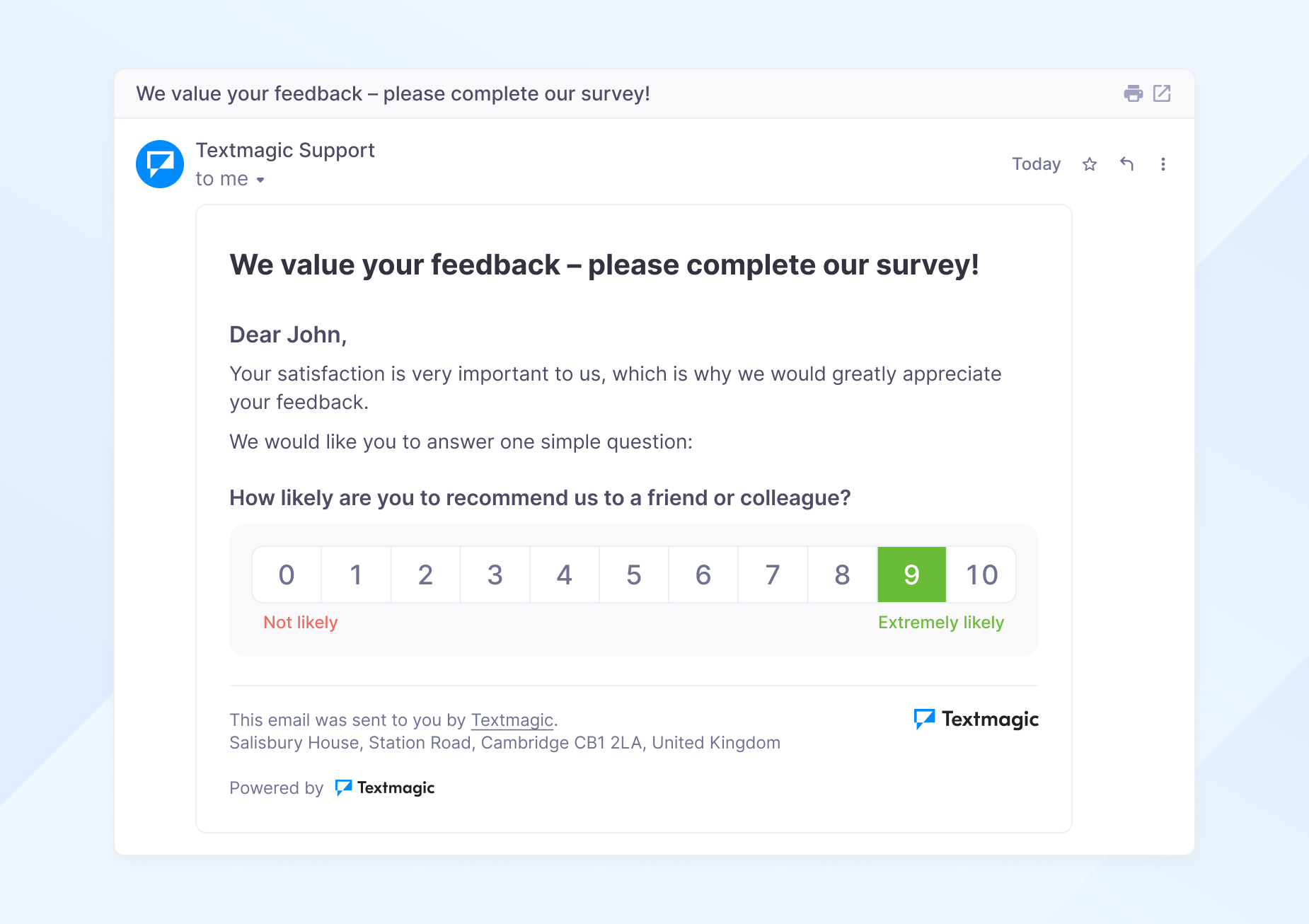
4. Customer satisfaction survey email
Customer satisfaction survey emails are a powerful tool to gauge your customers’ happiness and overall experience. They allow you to collect feedback directly and gain insights into customer preferences, opinions, and areas requiring improvement.
Subject line: We value your feedback — share your experience with us
Hello [Customer name],
I sincerely hope you’re doing well. As a company committed to providing outstanding service and high-quality products, we value your satisfaction above all else.
That’s why we’re contacting you today – we genuinely want to hear about your recent experience: [link to your survey]
We appreciate your willingness to share your feedback.
Warm regards,
[Your name]
[Your position]
[Your company name]
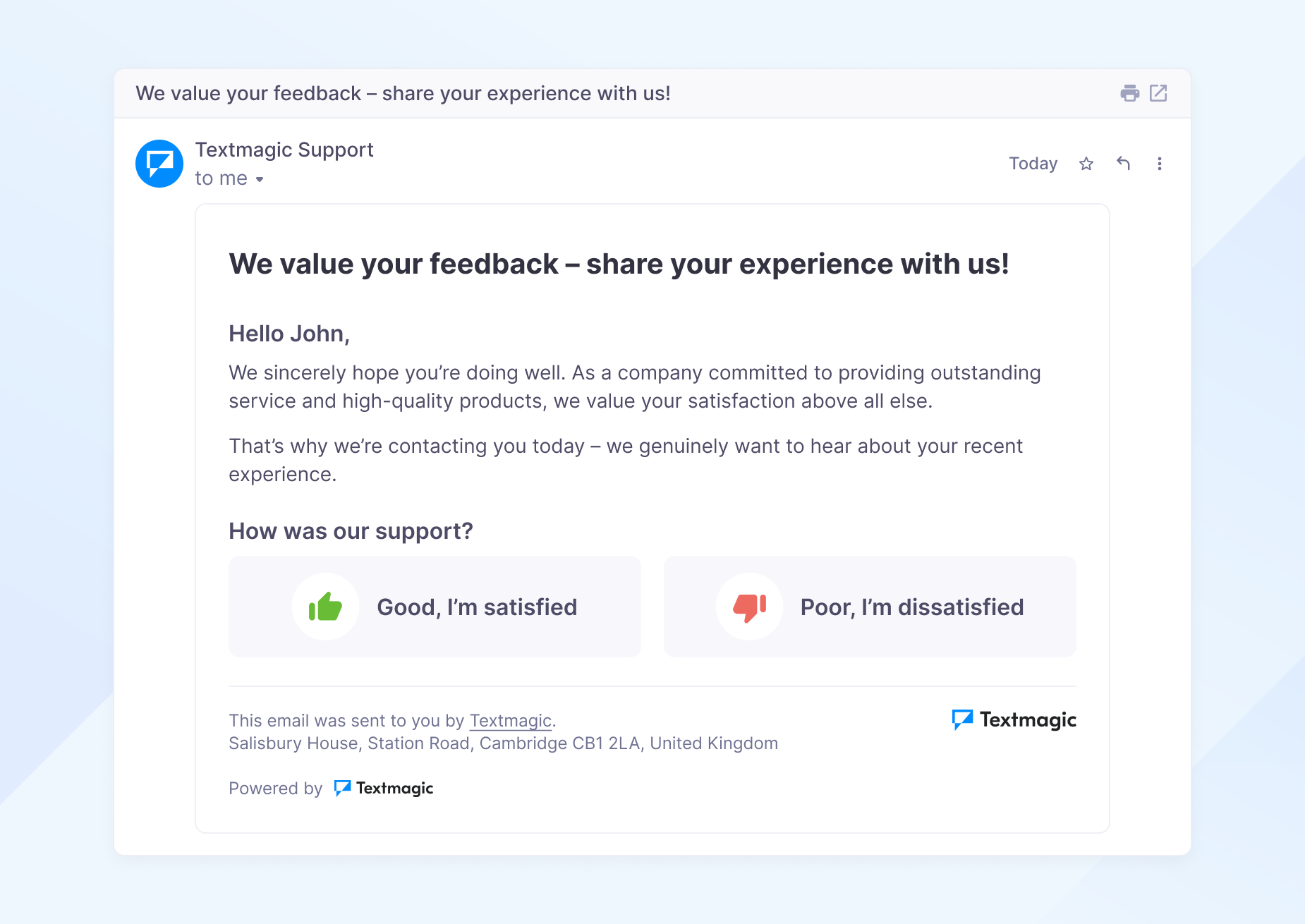
5. Participation survey email
Companies send a participation survey email to individuals who have attended or expressed interest in attending an event.
The survey is designed to gather feedback and insights about the participants’ experience and satisfaction. It emphasizes the importance of the participants’ opinions in shaping future events and improving the experience.
Subject line: We’d like to hear from you
Hey [Customer name],
I hope you enjoyed the [Event name]! We aim to provide the best experience for all participants and value your feedback, so we’re reaching out to you directly.
Could you spare five minutes to share your thoughts? Your feedback is incredibly important to us, as it helps us improve. Click the link to complete the survey and let us know how we did: [link to your survey]
Thank you! We hope to see you again at [Future event name]!
[Photo: participation survey email]
Best regards,
[Your name]
[Your position]
[Your company name]
6. Product or service review email
Businesses send this type of email to their customers to request a review of a specific product or service they have purchased or utilized. The email may mention the importance of customer reviews in improving the business’s services, thus helping other potential customers make informed decisions.
Subject line: We’d love to hear your thoughts on [product/service]
Hi [Customer name],
I hope you’re enjoying our [product/service]! Your opinion means a lot to us, and we would greatly appreciate your feedback.
Our short survey will take just a few minutes of your time and will provide us with valuable insights to enhance future [product lines/software versions].
To get started, please click the link below and rate your experience with [product/service]:
[insert feedback scale with a link directly in the email]
Thank you!
Best regards,
[Your name]
[Your position]
[Your company name]
7. Research survey invitation
This email invites recipients to participate in a research study. It typically provides a brief overview of the survey’s purpose, along with details about the survey duration, confidentiality of the responses, and any incentives or rewards for participation. The invitation aims to highlight the value of the respondents’ opinions and contributions.
Subject line: [Customer name], we need your input — participate in our research survey
Hello [Customer name],
I hope this email finds you well. At [Your company name], we are conducting an important research study and need your valuable input. Your participation will help us gather insights so we can contribute to meaningful advancements in our field.
The survey will only take a few minutes, and your responses are completely anonymous. To participate in this research survey, click this link: [link to your survey]
Thank you in advance for your time and consideration. Your participation is instrumental in shaping the future of our research endeavors.
Warm regards,
[Your name]
[Your position]
[Your company name]
8. Survey email offering an incentive
Implementing an incentive-based approach within survey emails has become a strategic method to stimulate customer participation. This email promises an incentive or reward for participating, which could be a discount, a chance to win a prize, or some other special benefit.
Subject line: Your opinion matters — get rewarded for taking part in our survey
Hello [Customer name],
We greatly value your opinion and would like to invite you to participate in our survey.
By taking just a few minutes to complete the survey, not only will you help us improve our [product/service], but you will also be eligible to receive [specific incentive/reward].
To get started, simply click on the survey link. All your responses will remain confidential and used solely for research purposes: [link to your survey]
Thank you for your time and support. We look forward to hearing from you soon!
Best regards,
[Your name]
[Your position]
[Your company name]
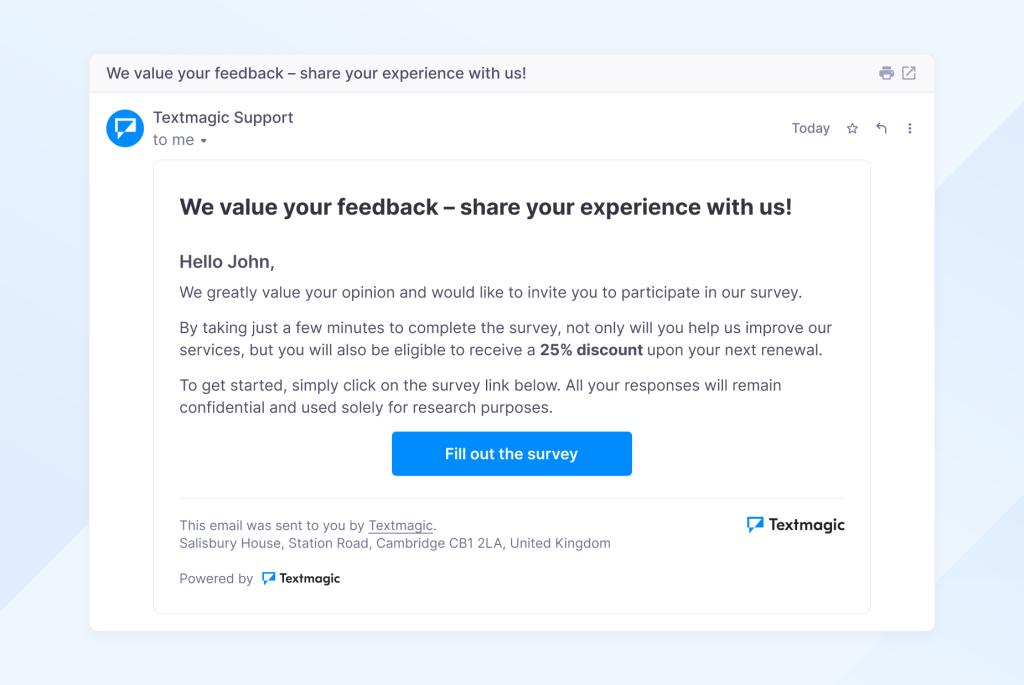
9. Survey invitation reminder
This email is a gentle nudge to recipients who haven’t responded to the initial survey invitation. It is a friendly follow-up message reminding them about the survey and encouraging participation, aiming to increase the response rate.
Subject line: [Customer name], did you get the chance to share your views?
Hello [Customer name],
I hope this email finds you well. We wanted to send a friendly reminder about the survey we recently invited you to participate in.
We understand that life can get busy and that the survey may have slipped your mind. However, we genuinely believe that your perspective can impact our efforts to improve our [product/service].
Please take a few moments to complete the survey: [link to your survey]
We truly value your time and contribution to our survey.
Best regards,
[Your name]
[Your position]
[Your company name]
10. Survey email with results
Organizations send an email with survey results to participants who previously took a survey. Practically, this email updates them on the survey’s outcomes and closes the feedback loop. Its purpose is to promote open communication and transparency between the organization and its customers.
Subject line: Thank you for participating — here are the survey results
Hello [Customer name],
I would like to express our sincere gratitude for your participation in our recent survey. Your valuable insights and feedback have helped us better understand your needs and preferences.
Here are some key findings from the survey:
- [Highlight a key result or trend]
- [Share another interesting insight]
- [Mention any noteworthy statistics or feedback]
We believe in transparency and keeping you informed, and we wanted to make sure you were among the first to know about the survey’s outcomes. We look forward to implementing the necessary changes and to continuing to serve you better.
Best regards,
[Your name]
[Your position]
[Your company name]
11. Loyalty program feedback email
This email is designed to contact customer loyalty program members. It is meant to gather feedback and improve their experience.
Subject line: [Customer name], we value your opinion about our loyalty program
Hello [Customer name],
Thank you for being a loyal member of our [Your loyalty program name]. We’d love to hear your thoughts regarding your experience.
Will you take a few moments to complete our short survey? Your feedback will guide us in making the program even more rewarding: [link to your survey]
Thank you for taking the time to share your valuable feedback.
Warmest regards,
[Your name]
[Your position]
[Your company name]
12. Subscription renewal feedback email
Before a customer’s subscription ends, they usually receive an email asking for feedback. The subscription renewal feedback email aims to understand their satisfaction with the service and their intentions regarding renewal.
Subject line: We’d love your input — Help us improve before your renewal
Hello [Customer name],
I’m reaching out because your subscription to [product/service] is coming up for renewal soon. We’re always striving to improve, and your feedback is incredibly valuable to us.
Could you please take a moment to share your thoughts on your experience with [service/product] so far? What have you enjoyed most? Is there anything we could do better? Access the survey here: [link to your survey]
Thanks so much for your time!
With appreciation,
[Your name]
[Your position]
[Your company name]
13. Email questionnaire template
Email questionnaires are a great tool for gathering in-depth feedback from your audience. They go beyond basic surveys by using a mix of question formats — multiple-choice, open-ended questions, and rating scales — to get a more nuanced understanding of customer experiences.
Subject line: Your thoughts matter — help us improve [product/service]
Hi [Customer name],
We’re always looking for ways to improve [product/service], and your feedback is essential to that process. We’d love to hear about your experience so far, both the good and the bad.
We’ve put together a short questionnaire to gather your valuable insights. It shouldn’t take more than [estimated time] to complete.
We recognize that your time is precious, and as a gesture of our gratitude, we would like to offer you [specific incentive/reward].
This is the survey:
[Insert question 1]
[Multiple-choice options]
[Insert question 2]
[Rating scale]
[Insert question 3]
[Open-ended response]
Feel free to skip any questions you prefer not to answer or add additional comments where you see fit.
Thank you for contributing to our journey!
Best regards,
[Your name]
[Your position]
[Your company name]
14. Customer support feedback email
After a customer interacts with your support team, you may send a feedback request email to gather insights into their experience. Your questions should be phrased around the customer’s experience with your support agents, such as the helpfulness of the solution provided, the agent’s communication style, and overall satisfaction.
Subject: Checking in — how was your recent support experience?
Hi [Customer name],
We recently helped you with [specific issue]. We’re always striving to provide the best possible support, and your feedback is incredibly valuable to us.
Would you mind taking a quick moment to share your thoughts on how we did? What worked well? Was there anything we could have done better?
Access the survey here: [link to your survey]
Thanks for your time!
Kind regards,
[Your name]
[Your position]
[Your company name]
15. Survey invitation email about trial satisfaction
A survey email about trial satisfaction is a targeted message sent to users who have recently finished a trial period for a product or service. The goal is to gather honest feedback about their experience.
Subject line: [Customer name], how was your trial experience?
Hello [Customer name],
We’re thrilled that you decided to give our [product/service] a try! As your trial period is coming to an end, we’d love to hear about your experience.
Please fill out this survey and share what you loved and what could be better: [link to your survey]
Thank you for choosing us.
Best,
[Your name]
[Your position]
[Your company name]
Email survey best practices
Here are some helpful suggestions to create highly effective survey emails that encourage recipients to respond.
- Offer incentives: Consider enticing recipients to participate by offering incentives such as discounts, gift cards, or entry into a prize draw.
- Keep the survey short: Ensure that the survey is concise and focused, with a limited number of questions. This increases the likelihood of completion and reduces respondent fatigue.
- State how long it will take to complete: Communicate the estimated time required to complete the survey. This helps manage expectations while allowing recipients to plan accordingly.
- Explain the purpose of the survey: Articulate the objective and purpose of the survey. This helps recipients understand why their feedback is valuable and motivates them to participate.
- Be thankful: Express appreciation to recipients for their time and willingness to provide feedback. A simple thank-you message goes a long way in building rapport and encouraging future participation.
- Share the results: Share the summarized results with the participants after collecting and analyzing the survey responses. This demonstrates transparency and appreciation for their contribution.
Ready to send your first email survey?
By using the 15 email survey templates provided in this blog post, you can ensure that you gather valuable customer feedback to improve your offerings and meet expectations. Remember, happy customers are loyal customers.
Design survey emails thoughtfully and effectively to get the most out of them. Leverage customer feedback tools to manage, analyze, and act on the feedback you receive.
b
l
o
g
Related articles
Cold texting: A complete guide & why you should warm text instead
This article explains the concept of cold texting an...
5 Simple steps to implement an effective closed feedback loop
Build a closed loop to improve your product with eve...
26 Customer service memes that made our followers LOL
Humor plays a crucial role in building personal conn...
Text message errors: Common SMS error codes and how to fix them
Text messages play a key role in facilitating both b...
4 Google Sheets SMS integrations with Textmagic and Zapier
Google Sheets is a free spreadsheet app that is part...




